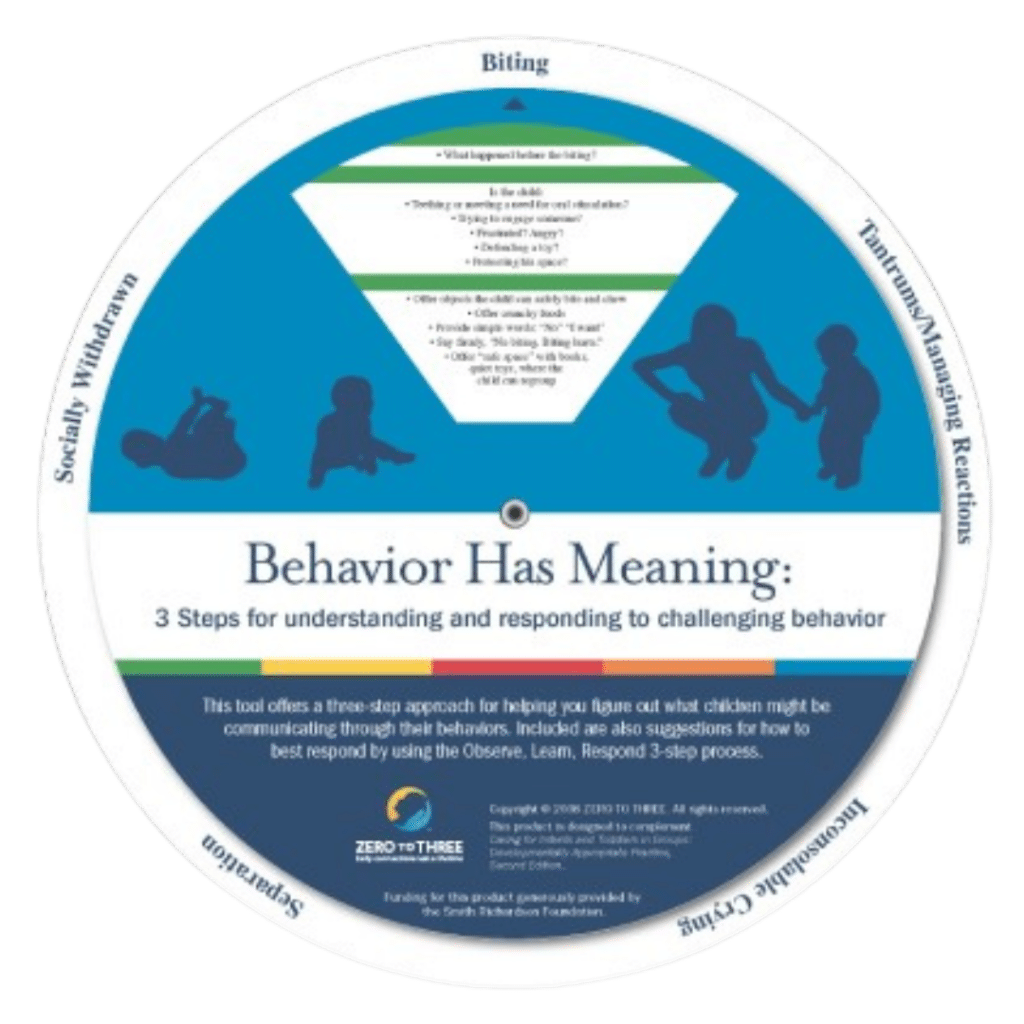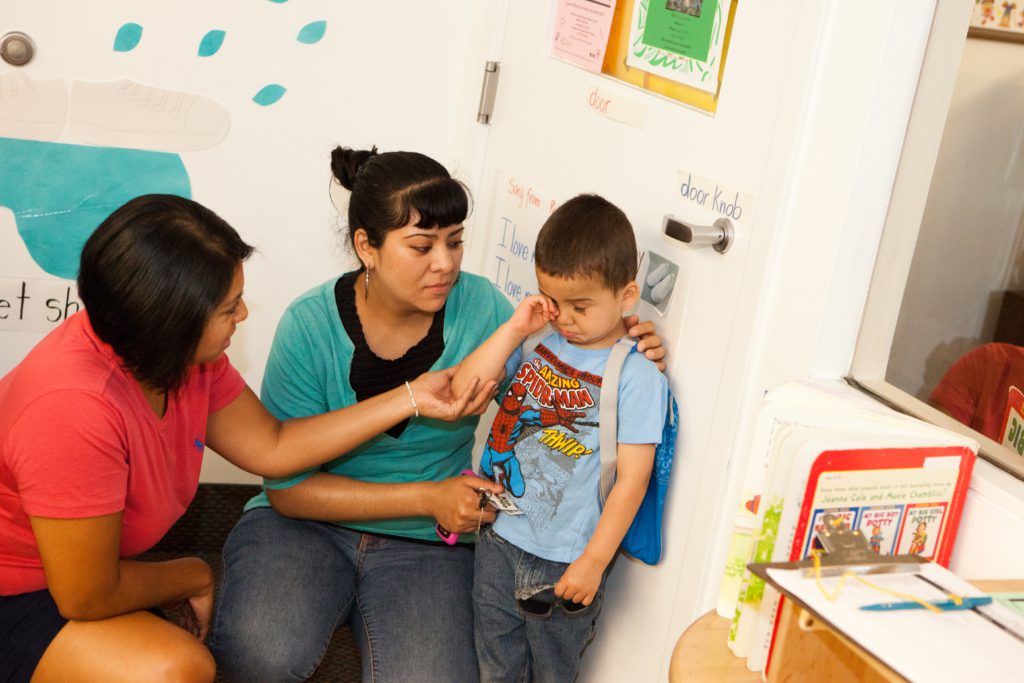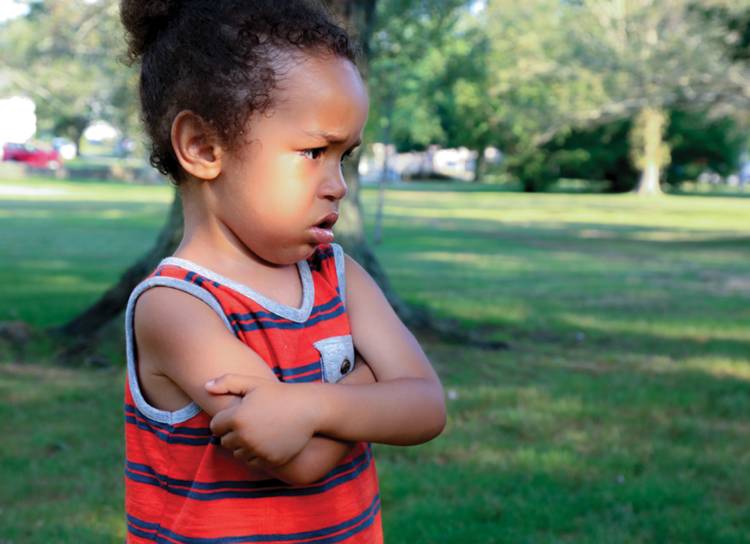Explore tools to help caregivers understand and approach behaviors such as biting and tantrums.

This means that they are eager to assert themselves, communicate their likes and dislikes, and act independently (as much as they can!). At the same time, it’s common to experience aggressive behavior in toddlers because they still have limited self-control and are just beginning to learn important skills like waiting, sharing and turn-taking.
Sherman, age 2, grabbed the red bucket and began shoveling sand into it. Jojo, the previous “owner” of the bucket, shouted: “Mine! My bucket!” When words don’t get his bucket back, Jojo grabs for the bucket, but Sherman pulls it away and jumps out of the sand box. Jojo follows Sherman, pushes him, grabs the bucket, and returns to the sandbox. When Sherman approaches the sandbox once more, Jojo carefully guards his bucket, wrapping his arm around it and watching Sherman closely. Their parents, who had seen the drama unfold, walk across the playground and recite the “use your words” speech for what feels like the millionth time.
As toddlers are also just beginning to use words to communicate, they rely heavily on their actions to “tell” us what they are thinking and feeling. When a toddler wants a toy, he may take your hand, walk you to the toy shelf, and point to the one he wants, essentially “saying” with his gestures, “Daddy, I want to play with that toy. Please get it for me.” When he is angry, frustrated, tired or overwhelmed, he may use actions such as hitting, pushing, slapping, grabbing, kicking, or biting to tell you: “I’m mad!” “You’re too close to me, get away!” “I’m on overdrive and need a break.” Or “I want what what you have!”
Children who are intense and “big reactors” tend to have a more difficult time managing their emotions than children who are by nature more easygoing. Big reactors rely more heavily on using their actions to communicate their strong feelings.
As parents, one of your most important jobs is to help your toddler understand and communicate their feelings in acceptable, nonaggressive ways. This is no small task. It requires a lot of time and patience. But with your support and guidance, your child will learn to manage their strong emotions and reactions over the next months and years.
No two children or families are alike. Thinking about the following questions can help you adapt and apply the information and strategies below to your unique child and family:
With caregiver support and guidance, children will learn to manage strong emotions and reactions over the next months and years.

Explore tools to help caregivers understand and approach behaviors such as biting and tantrums.

Lacey, aged 11 months, wants a bite of the cookie her mother is eating. Lacey kicks her feet, waves her arms, and makes lots of sounds. But her mother just gives her another spoonful of squash. Lacey swings her arms and knocks the spoon out of her mother’s hand. Squash on the wall! Lacey bangs her hands on the high chair and starts to cry.
One of the greatest challenges in dealing with aggressive behavior is that it can feel very hurtful to parents, both emotionally and physically. When your baby yanks on your nose and won’t let go, grabs at earrings, pulls hair, bites when breastfeeding, or bats his hand at you when you take away a forbidden object, it is perfectly natural to feel a flash of frustration or even anger. However, babies do not mean to hurt or upset their loved ones. They are simply exploring the world around them through their senses. They learn how the world works by biting, mouthing, grabbing, shaking and dropping, and swatting and seeing what happens as a result, which is usually a pretty big reaction.
Justin, aged 16 months, is having a great time with his father’s cell phone. He presses buttons and makes all kinds of pictures come up on the screen. When his father sees what Justin is doing, he grabs the phone out of his hand and says, “No way, buddy. This is not for kids.” Justin shouts back: “I want dat!” as he kicks his father with gusto. When his dad picks him up to calm him down, Justin kicks again with both feet.
Aggressive behavior in toddlers (hitting, kicking, biting, etc.) usually peaks around age two, a time when toddlers have very strong feelings but are not yet able to use language effectively to express themselves. Toddlers also don’t have the self-control to stop themselves from acting on their feelings. They are just beginning to develop empathy—the ability to understand how others feel. So, they cannot yet say, “Mommy, I am mad that Zachary grabbed my favorite doll. But I know he just wants to play with me. So how about I offer him a different doll to play with?”
Instead, your toddler may bop Zachary on the head with a toy truck.
Bella, aged 30 months, is having a hard time saying goodbye to her mom at child care. As her mother starts to leave, Bella reaches out for her, sobbing, “Don’t go, Mommy!” Chandra, Bella’s friend, comes over to try and comfort Bella. Bella surprises her by roughly pushing her arm away and running to her cubby. Bella sits curled up under her coat hook, crying. When Talisa, one of the teachers, approaches Bella to see if she wants to read a story, Bella hits her. Talisa remains calm, holds Bella close, and tells her she knows Bella is sad that her mommy left and that it’s okay to be sad, but hitting is not okay. She then helps Bella get involved in an activity with her friends.
Aggressive acts, such as punching a parent, often emerge when toddlers are overwhelmed by a distressing situation or by difficult feelings like anger or jealousy. These moments can be extremely challenging for parents because they are hurtful. Parents often expect that as their older toddles become more and more verbal and advanced in their thinking skills, they are capable of more self-control than they really are. This stage of development can be very confusing because while your 2 ½-year-old may be able to tell you what the rule is, they still do not have the impulse control to stop themselves from doing something they desire. At this age, emotions still trump thinking skills almost every time.
The bottom line is that when you see aggressive behavior in toddlers, it is an important sign that they are out of control and need help to calm down before any teaching or learning can take place. Staying calm yourself is the best response as it helps your child calm down more quickly. Read below for ways to handle aggressive behavior in toddlers.

Thinking through the following questions can help you see patterns and figure out what the underlying reason for your child’s behavior might be. You can use this information to decide the best way to respond.
As you review the strategies described below to manage aggressive behavior in toddlers, keep in mind that their effectiveness may vary based on both the age and stage of development of your child and on his or her temperament. They are not offered as prescriptions, but ideas that can be adapted to meet the needs of your individual child and family.

1. Be consistent.
Consistency with rules is key to helping children learn to make good choices. If every time a child throws a toy it gets taken away for a few minutes, he learns not to throw toys. But when the rules keep changing, it makes it hard for young children to make good choices. If one day a tantrum doesn’t result in getting to stay longer at the park, but the next day her protests get her four more trips down the slide, your child will be confused about what choice to make, “Well, making a fuss worked the other day so maybe I should try that again.”
2. Avoid negotiation.
This is tough. We want to make sure our children feel heard, see us as open-minded, good listeners, and we want to be flexible. But negotiating about family rules is a slippery slope. A child who can negotiate for extra cookies or a later bedtime will quickly learn that this is a very effective way to get these “fringe benefits.” Soon you will find yourself negotiating everything. Having consistent rules—about things like holding hands in a parking lot, sitting in a car seat, or brushing teeth—actually helps children feel safe and secure. They come to understand that there is structure, logic, and consistency in their world.
3. Give your child a chance to problem-solve before stepping in. Whether it is finding the right place for the puzzle piece she is holding, or negotiating with a friend about who gets to swing on the swing first, let your child try to figure out a solution first, before you step in to help. (When he does come to you to solve the problem, you might help him along by making suggestions: Blocks can be so frustrating! How about trying to put more blocks on the bottom so that your tower doesn’t fall down?) You may be surprised to see how capable he is at managing conflict and dealing with the challenges he faces.
4. Give your child lots of positive feedback when she shows self-control.
Children want to please. When you respond positively to their behavior, you reinforce that behavior and also build their self-esteem. You stomped your feet when you were mad rather than hitting. Great job! Children who feel good about themselves are more likely to be well-behaved. It is important to help children experience and understand the natural benefits of good behavior. For example, if they cooperate with teeth-brushing instead of protesting it, there is time for an extra book at bedtime.

However, if a child’s aggression is interfering in his ability to interact with others in positive ways, in his ability to explore and learn, or if you find that because of your child’s aggressive behavior you avoid having him play with other children or taking him to other activities, it can be very helpful to seek guidance from a child development professional.
Certain behaviors do warrant additional attention when they happen often and continue over time. Examples include when a child:
Gentle parenting is not permissive parenting.

|
2025 LEARN Conference registration is now open! Join us in Baltimore Oct. 8-9.
|